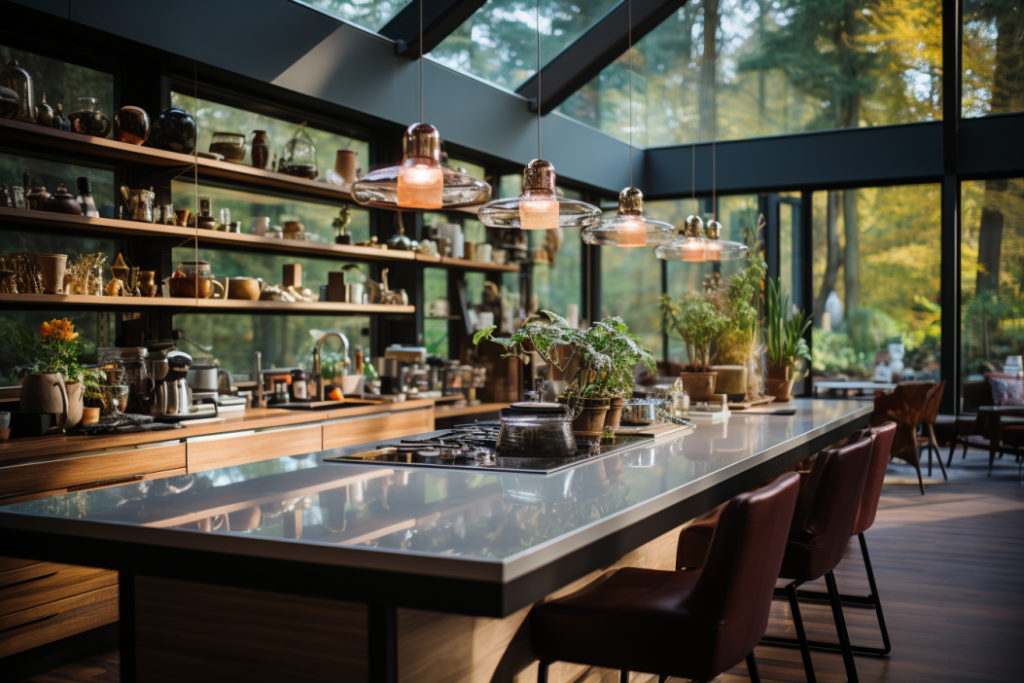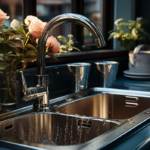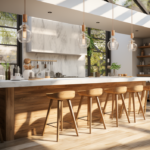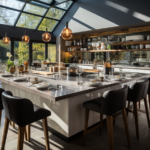Table of Contents
Transform Your Industrial Kitchen into a Modern and Efficient Space with These Proven Design Strategies
If you’re planning to remodel your industrial kitchen, there’s no reason to get overwhelmed by the process. With a bit of creativity and some key design strategies, you can create a sleek, modern, and functional workspace that suits your needs and style. In this article, we’ll share five easy-to-follow tips to help you achieve the industrial kitchen of your dreams. From selecting the right materials, to maximizing storage and workflow, you’ll discover simple and practical ideas to enhance the aesthetics and functionality of your kitchen. So, let’s get started and make your industrial kitchen a space you’ll love to cook and entertain in!
Prioritize functionality
Subheading: Prioritize functionality
When designing an industrial kitchen, it’s important to prioritize efficiency, practicality, and functionality. Your kitchen should be a space where you can prepare meals comfortably and efficiently, without wasting time or energy. Here are some tips to make sure your kitchen is functional yet stylish:
- Plan your layout: Start by considering the dimensions and layout of your kitchen. Think about the workflow and create a plan for the placement of appliances, cooking stations, counters, and seating areas. This will help you maximize the space and create a smooth and efficient workflow.
- Choose durable materials: Industrial kitchens are subjected to high traffic, heat, and moisture, so it’s important to choose durable and resilient materials that can withstand these conditions. Stainless steel, concrete, brick, and natural wood are popular choices for industrial-style kitchens. These materials are strong, hygienic, and easy to maintain.
- Optimize storage: In an industrial kitchen, storage is essential. You need ample space to store your equipment, utensils, and ingredients. Consider open shelving or wall-mounted racks to keep your items within easy reach. Don’t underestimate the importance of pantry space- you will need a large and organized pantry to keep your kitchen neat and efficient.
- Illuminate your space: Good lighting is crucial in any kitchen, particularly in an industrial kitchen where safety and precision are key. Make sure your kitchen is well-lit with overhead lights, task lights, and ambient lighting. Pay attention to the color of your lights. Some colored lights reduce productivity and clarity. Stick to white or light yellow lights.
- Invest in professional-grade appliances: Professional-grade appliances can withstand the rigors of industrial cooking and give your kitchen a polished look. Consider investing in high-quality stovetops, ovens, refrigerators, and dishwashers. Remember that appliances must be correctly sized to optimize the layout and meet cooking demands.
In summary, prioritize functionality in your industrial kitchen design. This will ensure that your kitchen is not only stylish but also practical and efficient. Plan the layout, choose durable materials, optimize storage, illuminate your space, and invest in professional-grade appliances to create an industrial kitchen that meets your needs and delivers delicious results time and time again.
Incorporate industrial materials
Incorporating industrial materials into your kitchen design is one of the key elements that define an industrial style kitchen. Industrial materials such as stainless steel or polished concrete not only give your kitchen a modern look but also have a practical purpose. These materials are durable, easy to maintain, and can withstand high traffic and heavy use.
Stainless Steel
Stainless steel is a popular choice for industrial kitchens because it has a sleek, professional look, and is easy to clean. Stainless steel appliances, countertops, and cabinets can be the perfect addition to your kitchen. In addition, stainless steel provides excellent durability and minimal maintenance, making it a popular choice for commercial-grade kitchens.
Polished Concrete
Polished concrete is another industrial material that can add a unique and modern touch to your kitchen design. Often used for flooring or countertops, polished concrete offers a simple and understated design that can match any color scheme. Concrete is also durable and easy to maintain, making it an excellent choice for busy kitchens.
Reclaimed Wood
Reclaimed wood is a more sustainable choice compared to new wood, and it’s another popular material for industrial kitchen design. It offers a rustic appearance and has a unique texture, which can provide contrast against stainless steel or polished concrete. Additionally, reclaimed wood is versatile enough to be used for cabinets, tables, or flooring.
Incorporating industrial materials into your kitchen design can be overwhelming, but it’s essential to find the right balance. Including too many industrial materials can make your kitchen seem too sterile and cold, while not incorporating enough materials can make it seem unfinished. Consider adding elements such as wood or natural finishes to soften the material’s harshness and add warmth to space.
Overall, when incorporating industrial materials into your kitchen design, prioritize the materials that have practicality and durability while also having a unique aesthetic quality that ties the room together. Remember, less is often more when it comes to industrial kitchen design.
Optimize lighting and color
Optimize lighting and color
Another critical aspect to consider in designing your industrial kitchen is lighting and color scheme. A combination of proper lighting and colors can create a functional yet relaxed ambiance and improve the functionality of the kitchen.
Natural lighting
Natural lighting is an essential aspect to consider in industrial kitchen design. Consider installing large windows and skylights to enable natural light to illuminate the kitchen. Natural light helps enhance the aesthetics of the kitchen and can create a more enjoyable and comfortable environment for chefs.
Task lighting
Task lighting is essential for any industrial kitchen. During food preparation, task lighting helps alleviate eye strain, prevent accidents, and ensure chefs have maximum visibility. Consider installing track lighting beneath cabinets or LED overhead fixtures to look over work surfaces.
Colors
Incorporating a specific color palette is crucial when creating an industrial kitchen. Consider using neutral colors, such as grays, blues, and dark browns, that help create a sophisticated and relaxed atmosphere. Dark colors also have the benefit of creating a less grimy-looking space since they hide grease and other stains.
When choosing colors, you should consider the type of industrial material you’ll use for flooring and countertops. Brighter colors can create a striking contrast, adding a bit of vibrancy to a dark palette. Alternatively, you can integrate a vibrant color accent to add life to the kitchen.
Conclusion
Optimizing lighting and color can significantly improve the vibe of your industrial kitchen. Whether it’s natural lighting or task lighting, being thoughtful and creative in your design can help create a functional, relaxed, and inviting space. Experiment with different colors, shapes, and light fixtures until you find the perfect look for your kitchen. Remember, with the right lighting and color scheme, you can drastically upgrade the look of your industrial kitchen.
Maximize storage space
When designing an industrial-style kitchen, choosing the right lighting and color scheme can play a role in creating the perfect ambiance for your cooking space. To help you achieve a visually appealing and efficient kitchen, here are some essential tips that you can consider focusing on.
Prioritize Functionality
As with any kitchen, the main goal of an industrial kitchen is to create an area that is practical and efficient. When it comes to lighting, you’ll want to ensure that the kitchen is well-lit, especially in the cooking areas where you’ll need plenty of illumination to make sure your meals come out perfect every time. For larger industrial kitchens, installing task lighting can help to ensure that specific areas are adequately illuminated, whereas more compact spaces can benefit from a single strong source of ambient lighting to create a cozy and welcoming ambiance.
Incorporate Industrial Materials
Industrial kitchens often feature rustic materials like wood and metal, and lighting fixtures should follow this design theme. As a result, the lighting fixtures you choose should complement the feel of the space. Copper, metal, and galvanized steel are great materials to work with when adding light fixtures. Adding these materials in small ways, like table legs, chair designs, or even a hanging light fixture, will make the space feel cohesive and balanced.
Optimize Lighting and Color
For industrial kitchen design, neutral hues like shades of gray, cream, and white work well. They are clean, inviting, and bright, making the room appear more massive than it might be. Colors like brown and black also work well as accent colors in the kitchen. Just be sure to balance any darker colors with neutral hues to create the right effect. The lighting fixtures can also feature a matte or frosted finish to provide the room a softer glow.
Maximize Storage Space
When designing your industrial kitchen lighting scheme, it’s essential to keep in mind that industrial kitchens must be functional. Keeping countertops clean and free of clutter is an integral part of the design aspect. The right type of lighting can enhance your storage and preparation space while also helping the space appear bigger than it is. Installing under-cabinet lighting or accent lighting can serve as task lighting and ambient lighting, illuminating the workspace while also adding contrast.
In conclusion, choosing the right lighting and color scheme will help you achieve an excellent industrial kitchen design. Keeping in mind the functionality of your space while selecting lighting fixtures and complementary colors is key. Keep it simple and cohesive in design while maximizing your storage space to provide an efficient cooking area. By following these tips, your industrial kitchen will feel balanced, welcoming, and cozy.
Add a touch of personality
Whether you’re an avid home cook, a professional chef, or simply enjoy spending time in the kitchen, your workspace should reflect your personality and style. By adding a few touches of personality, you can transform your industrial kitchen into a cozy, inviting space that feels like home. Here are five easy tips to help you add a touch of personality to your industrial kitchen:
1. Incorporate Decorative Accents
One of the simplest ways to add personality to your industrial kitchen is to incorporate decorative accents that reflect your style. Consider adding a colorful rug, wall art, or a statement piece like a chandelier or pendant lighting.
2. Customize Your Cabinets
Customizing your cabinets can be a unique way to add personality to your kitchen. You can opt for colored cabinets, glass-front cabinets, or open shelves to display your favorite dishes or kitchen accessories.
3. Display Personal Collections
If you have a collection of cookbooks, vintage dishes, or other kitchen-related items, consider displaying them creatively. You can incorporate them into your décor by displaying them on open shelving or leaving them on your countertop.
4. Add Seating
Adding seating to your kitchen is a great way to add personality and functionality. Consider adding bar stools, a bench, or comfortable chairs to create a cozy and welcoming space.
5. Use Unique Materials
Using unique, non-traditional materials can add a sense of personality to your kitchen. You can use reclaimed wood, recycled metal, or other unique materials to create your countertops, backsplashes, or other kitchen elements.
By incorporating these tips, you can add personality and charm to your industrial kitchen, creating a space that is both functional and inviting. Remember, your kitchen should be a representation of your style and personality, so don’t be afraid to get creative!
Conclusion
In conclusion, designing an industrial kitchen doesn’t have to be daunting. By incorporating these simple yet effective tips, you can achieve a stylish and functional kitchen that meets your needs and personality. From prioritizing functionality to adding industrial materials, optimizing lighting and color to maximizing storage space, and adding a touch of personality, the possibilities are endless. Remember to stay true to your style and preferences, while also considering the practicality of your design choices. With a bit of creativity and planning, you can have the industrial kitchen of your dreams that is both inviting and efficient.









